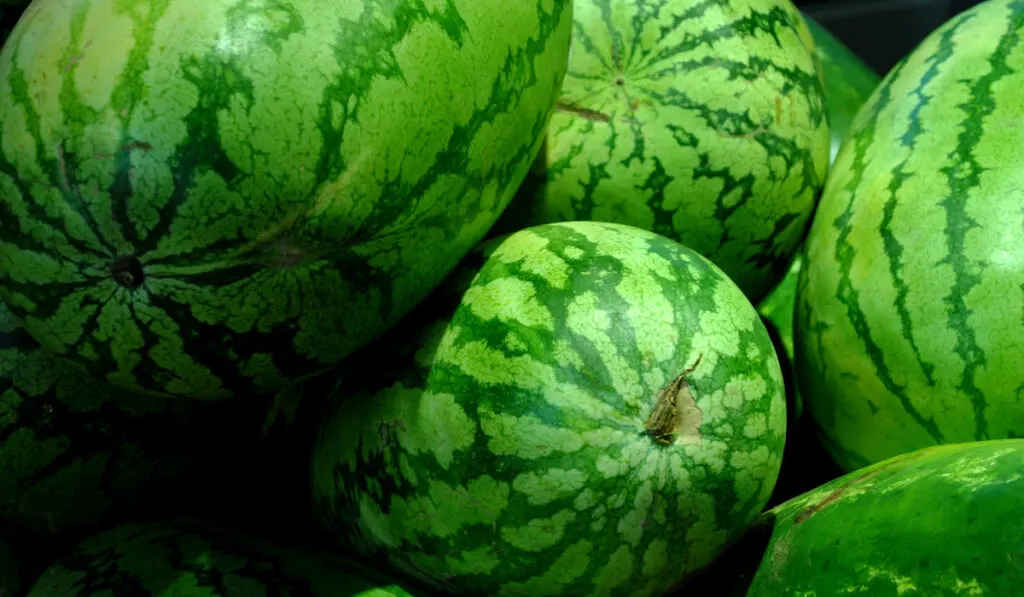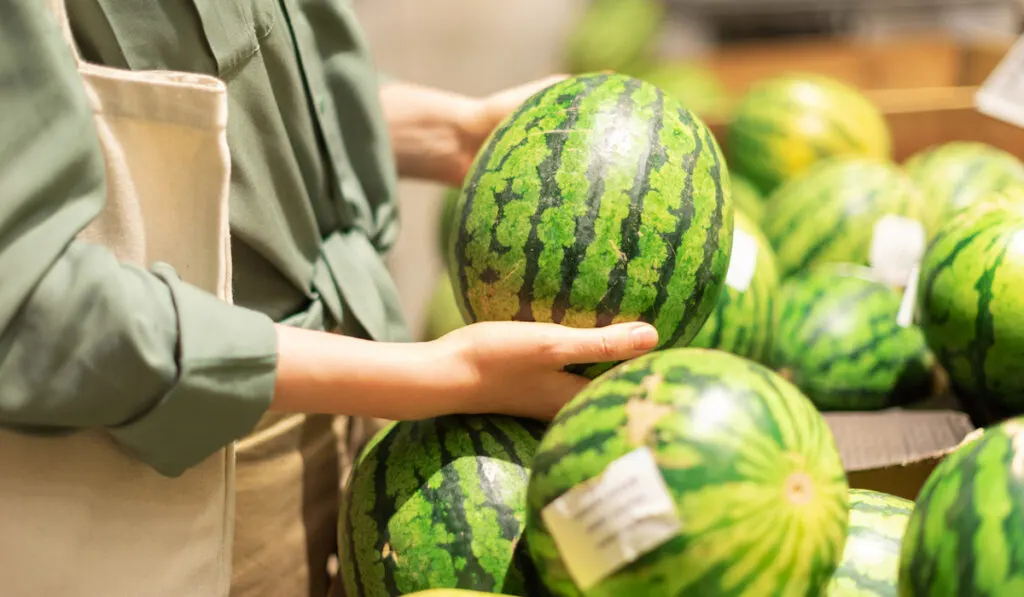Watermelon is a refreshing summer treat with a light sweet taste. You can make some fruit salads with it, accompany it with meals, eat when thirsty, and whenever you wish to.
However, shopping for watermelons seems like a gamble for many people. You don’t want to end up with a tasteless, unripe melon on your hands.
There are many ways to tell if your watermelon has gone bad.
In this article, you will learn different ways of checking for a bad and rotten watermelon and finding the best way to tell if your watermelon is fresh or not.

Table of Contents
What to Look Out for When Choosing Watermelons
1. Smell and Taste
Watermelons are juicy, fresh, and tasty. When you taste a melon, and the taste is sour, it has gone bad. This is because the sugars inside the melon have turned sour.
Whenever purchasing your watermelon, you must smell the watermelon to identify if the watermelon is good or bad. You want to look for a watermelon that has a sweet, pleasant smell. If it smells tangy or sour, don’t buy it as it is already spoiled.
2. Tap The Sides
Tap the watermelon and listen to the sound it produces. A deep hollow sound means the melon is good. If the melon sounds full, then it has already gone bad or is not yet ripe.
If you tap the watermelon and the sound produced is dull, the melon is mushy or rotten inside.
3. Check For Mold
Mold or spots on the rind of the watermelon means that it has gone bad. Any soggy patches that are black, white, or greenish-blue mean that the melon has gone bad.
4. Watermelon Patch
You can check if a watermelon is bad when looking at the patch or ripe spot on its skin. If the patch is yellow, that is a good watermelon.
If the patch is white, then it is not ripe and therefore not suitable for eating. A yellow watermelon spot indicates that the watermelon was sun-ripened.
5. Rind Color
The watermelon should have a healthy, consistent pine green shade or a striped alternating appearance of darker pine and lime green color on the outside. The watermelon should also appear dull and not shiny.
If it’s shiny, then it is not ripe. The stem should not be visible on the surface. Instead, you should look for a small crater that indicates that the melon fell off on its own. A stem suggests that it was plucked off before it was ripe.
6. The Shape
Choose a watermelon that is round and symmetrical. An irregular shape means that the watermelon is rotting inside.
A watermelon with cuts, dents, or irregular bumps indicates that the melon had an inconsistent water supply or was not properly pollinated. Cuts or dents on a watermelon could also mean the presence of fungus or insects.

7. Weight
A good watermelon should be heavy. This is due to the fiber and water content in the melon. Heavier water watermelons are sweeter and juicier. A bad watermelon is lighter, which means it has less water content.
A lighter than usual watermelon indicates that the watermelon is drying out inside.
8. Red or Deep Pink Flesh
You should look for deep pink or red flesh with black seeds when you cut a watermelon, although seedless watermelons also exist.
This will mean that your melon is ripe, sweet, and healthy. If the watermelon has a different color, then it has gone bad, and you should not eat it.
9. Dry and Gritty
Do not buy dry and gritty watermelon flesh as it is no longer suitable. This is because the gritty flesh will start to wither in time and pull away from the seeds and become mushy and slimy.
This watermelon has ripened past its optimal point. Refrigerating your melon leftovers will ensure that they do not become dry and gritty from exposure to air.
10. Firmness
Check how resistant the rind or skin of your watermelon is by scratching with a thumbnail. If the skin easily gives cuts through or gives in to the pressure when you press it, then the melon is bad or overripe. If the flesh is water-soaked, it will disintegrate, and become saggy and dark. This could be due to a fungal infection.
The inside of the melon should not be mushy. A mushy watermelon is due to air exposure inside the watermelon. If your watermelon is slimy, mushy, or discolored, toss it.
11. Expiration Date
When you purchase a pre-cut watermelon, it will usually come with an expiration date. However, this does not guarantee that the melon will not be spoiled before that date.
If you eat watermelon with a sour, fizzy, or tangy taste despite not having reached the expiration date, spit it out and throw away the rest.

Storing Your Watermelon
Watermelons are not only well known for being delicious, but they are also known to have a high water content making them perfect for eating on a hot summer day. The problem with watermelons is that they spoil very quickly if you do not store them correctly after purchasing them.
How you store your watermelons will determine how long they last before spoiling or rotting.
Make sure that your watermelon is in a cool, dry place. When storing your watermelon, cut it in half and then put each half into separate plastic bags and store them in the bottom of your refrigerator. This will reduce how long it takes for your watermelons to spoil since they are not touching the cold frozen sides in the fridge.
If you store uncut watermelon in the fridge, be sure to eat it within ten days or else it will start to turn bad. Also, don’t store your melons near fruits or vegetables that give off ethylene gas because this will cause your melons to spoil quickly.
Watermelons are big, and storing them in the fridge can be tricky. You will need to cut them into pieces and wrap them so that they can stay fresh longer. Only remove the amount of watermelon you need and store the rest in an airtight container.
You can also store whole watermelons at room temperature and out of direct sunlight without them going bad. However, you will still need to store them in the fridge within two weeks of purchasing them.
Tightly wrap the cut end of the watermelon with plastic wrap. This will keep the watermelon from picking flavors from other foods in your fridge.
Preparation
When preparing your melon for consumption, make sure to wash it under cool running water and soap before cutting into it because there could be bacteria growing on the surface of the melon that you do not want to ingest.
Final Thoughts
Watermelons are one of the most popular summertime treats you will enjoy when you choose a good fresh one. Ensure you follow the steps mentioned above so that you can get yourself tasty and refreshing melons.
You should not eat watermelon that has already gone bad. Also, do not judge a watermelon by size alone. Instead, focus on factors like smell, patch color, texture, and many others to successfully choose a good watermelon fit for your table.
Resources:
- https://www.wikihow.com/Tell-if-a-Watermelon-Is-Bad
- https://www.myrecipes.com/extracrispy/has-your-watermelon-gone-bad
- https://www.healthline.com/nutrition/how-to-pick-a-watermelon#1.-Look-for-a-uniform-shape
- https://www.healthline.com/nutrition/how-to-pick-a-watermelon#How-to-spot-a-damaged-or-spoiled-watermelon
- https://www.leaf.tv/articles/how-to-tell-if-a-watermelon-is-bad/
